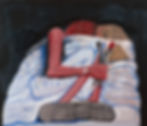Review: Philip Guston at Tate Modern
- Ernest Chlopicki
- Oct 6, 2023
- 4 min read
★★★★☆

Philip Guston, The Line, 1978. Oil paint on canvas, 180.3 x 186.1 cm. Promised gift of Musa Guston Mayer to The Metropolitan Museum of Art, New York © The Estate of Philip Guston, courtesy Hauser & Wirth.
The end of World War I marked to Virginia Woolf a shift in how we comprehend the coherence of self. Burst asunder and flown off in different directions, the self was now fragmented, lost, begging to be put together. Philip Guston (1913-1980), born into this malleable reality, saw it for its radical potential. ‘Probably the only thing one can really learn (…) is the capacity to be able to change’, declares Guston in a sentiment that serves as an opening motif to Tate’s new exhibition, an honouring of Guston’s dynamic legacy.
Although the works are displayed predominantly chronologically, it is thanks to Tate’s successful curation that the themes of movement, self-actualisation, and reinvention take prominence. Guston was an artist heavily influenced by, well, everything: wars, prevalence of racism, political and social upheavals of the long 20th century, but also his creative peers (musicians and poets), his travel destinations, colours, everyday life objects.
It is then interesting to see Tate begin this exhibition with an oneiric commentary. Two paintings adorn the first room, Legend (1977) and Painter (1980), both presenting a sleeping artist, either covered in plasters or bombarded with a random collection of objects. While it might feel tempting to see this space as an introduction to Guston’s dreamscape in a somewhat psychoanalytic turn, its function resembles more that of an archive’s reception. From there on, each room provides us with a variety of Guston’s wide-ranging influences, drawers of an artist’s brain where the memories are stored, rather than offering us fully formulated meanings that are ready for our consumption. Paul Valéry once said that a bad poem is one that vanishes into meaning, proclaims one of the walls. Indeed, Philip Guston at Tate is poetry at its rawest, a collection of works that are always in-between emotion and knowledge.
To the right of the front room, there is however a small dent in the linear progression of rooms to follow. Here lies the core of Guston as an artist: references to his childhood, political activism, and the masters he studied in search of his own voice. Perpetually displaced as a child of Jewish immigrants, Guston incorporates styles of Pablo Picasso and Giorgio de Chirico to reflect his own family history in paintings such as Mother and Child (1930), Female Nude with Easel (1935), and Nude Philosopher in Space-Time (1935), none of which were previously on display in the UK. These paintings are nothing like what Guston produces after, their cubism radically broken by Guston’s embrace of curvature, but they serve as a powerful showcase of his creative versatility.

Philip Guston, Couple in Bed, 1977. Oil on canvas, 20.6 × 24.0 cm. The Art Institute of Chicago. © The Estate of Philip Guston, courtesy Hauser & Wirth.
Before we get to the most exciting period of Guston’s career that started with the 1970 Marlborough Gallery exhibition, there is a whole bunch of rooms that trace Guston’s experimentation with colour-splashing and formlessness throughout the years. While captivating conceptually, this part of Tate’s curation struggles with the burden of sameness. There is perhaps only a degree of separation between each section, with the most exciting variable being an introduction of a new colour. Still, the final room on this side of the exhibition reflects on Guston’s artistic block, and it does so poignantly. By the mid-1960s, Guston was experiencing a major crisis in his creative life and his marriage with the poet Musa McKim. Having given up painting for around 18 months, he eventually began to produce simple drawings. There is a touching sentiment to Guston’s Untitled series (1968) - a collection of lines slowly morphing into shapes, then again into distinct objects: jars, light bulbs, books. Guston found something as simple as a straight line to be a source of inspiration and strength, as long as he kept his practice alive.
And it took him far. 1970s saw Guston reinvent himself in a myriad of ways. Equipped with hectolitres of the fleshy pink paint which Guston prepared daily by mixing reds and whites in his studio, his main object of scrutiny became the crimes of Ku Klux Klan. These rooms ooze a cartoonish type of violence, the colour pink serving as a reminder of human fleshiness, here on the cusp of life and death, creativity and destruction. Paintings such as The Studio (1969) are absolutely masterful, they are also a testament to an artist in a prime of his stylistic autonomy. Guston offered us a satiric vehicle perfect for both comedy and drama, something I can only describe as a mix of Once Upon a Time Life cartoons, Keith Haring, and perhaps Netflix's Big Mouth. In The Studio, he takes from Dutch masters such as Rembrandt who, in the age of Enlightenment, oftentimes painted themselves meta-referentially; a self-portrait which depicts an artist painting his own likeness, ad infinitum. Here, the artist is a hooded KKK member, sketching another hooded figure on a small canvas, which is how Guston reflected the role we all play in generational transmissions of violence and racial injustice. And while his 1970s paintings frown upon the brokenness of humanity, it is ironically precisely then that Guston picks himself up and becomes cohesive. Except this time it is not to embrace individualism, as the post-war philosophies would suggest, but to fight for what protects our humanity the most, which is community.
'Philip Guston' is on at the Tate Modern until 25 February 2024. Under 25s go for £5.
Edited by Samuel Blackburn















